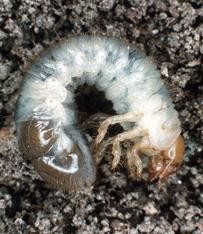 Once Japanese beetles mate and the eggs hatch, grubs will eat your grass and plant roots in the fall until they hibernate for the winter. In the spring, they'll begin eating again until they become adults, and then the cycle begins again. So it's wise to kill both the adults beetles AND the grubs.
Once Japanese beetles mate and the eggs hatch, grubs will eat your grass and plant roots in the fall until they hibernate for the winter. In the spring, they'll begin eating again until they become adults, and then the cycle begins again. So it's wise to kill both the adults beetles AND the grubs.
~~ Milky Spore Powder  kills Japanese Beetle Grubs ~~
kills Japanese Beetle Grubs ~~
Bacillus popilliae spores (the active ingredient) in Milky Spore infect and kill Japanese beetle larvae (grubs). Milky Spore is NOT a poison, so it won't harm plants, pets, beneficial insects, earthworms, fish, bees, birds, wild animals, or humans.
Milky Spore is approved and registered with the U.S. EPA (Environmental Protection Agency).
Milky Spore Powder begins working as soon as it is applied, as long as grubs are feeding. Once Japanese beetle grubs are infected, they will multiply the spores and spread them further. In warm climates, you can gain control over the grubs in under three years. Once in the soil, Milky Spore powder continues to infect grubs for 10 years or longer. That's a good investment!
begins working as soon as it is applied, as long as grubs are feeding. Once Japanese beetle grubs are infected, they will multiply the spores and spread them further. In warm climates, you can gain control over the grubs in under three years. Once in the soil, Milky Spore powder continues to infect grubs for 10 years or longer. That's a good investment!
You can apply Milky Spore powder anytime the ground is not frozen, but fall is the best time because grubs are more actively feeding to prepare for hibernation. The more grubs that ingest the powder, the faster it'll be spread underground.
To use Milky Spore, place a level teaspoon of the powder on top of the grass in your lawn every four feet and in rows four feet apart; like a grid pattern (apply it the same way in your garden). A 10 oz. container will treat 2,500 square feet, and a 40 oz. box will treat 10,000 square feet; about a quarter acre.
When you're finished, lightly water the area to soak the spores into the soil. As the grubs travel underground after they're infected, spores will spread so that the entire underground area becomes inoculated. This may take one to three years, but it's environmentally safe, you only have to apply the powder once, and once established, Milky Spore continues to work between 10 and 15 years.
AN EXTRA BONUS: You won't be bothered as much bymoles, voles, gophers, and skunks because they won't have many grubs to eat.
EXTRA NOTES ABOUT APPLYING MILKY SPORE:
~~ Do NOT mix the spore powder in water and spray it. The dust needs to be concentrated and applied in spots.
~~ Because the spore powder needs to be applied in spots, do not use fertilizer or grass seed spreaders.
~~ Don't mow your grass until the spore powder has been watered into the ground for at least 15 minutes.
~~Don't apply the powder on a windy day. Although it won't harm you if it gets on your skin or you breathe it, the wind may blow it away before you can water it. The powder needs to be applied in a concentrated area.
~~ Don't apply the powder if a heavy rain is expected. Although the powder needs to be watered to sink into the soil, you don't want it to be washed away.
~~ Keep in mind that using Milky Spore will reduce and eventually eliminate the Japanese beetle grub population, but it won't prevent the adult beetles from flying into your yard from untreated areas. But at least you won't be hatching your own beetles underground, so you'll have less to contend with each year.


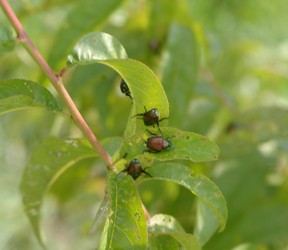 Japanese beetle adults eat flowers and foliage, leaving only leaf veins. They feed almost all summer, so if you don't get control of them early, your flower blooms and leaves will be eaten, and you may not have much of a garden crop.
Japanese beetle adults eat flowers and foliage, leaving only leaf veins. They feed almost all summer, so if you don't get control of them early, your flower blooms and leaves will be eaten, and you may not have much of a garden crop. 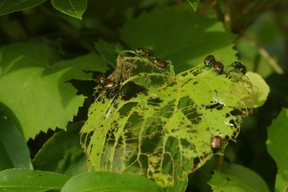 Adult Japanese beetles eat over 300 varieties of plants, so there aren't many that they don't attack.
Adult Japanese beetles eat over 300 varieties of plants, so there aren't many that they don't attack. 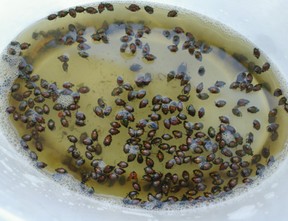 The safest and most inexpensive way to kill the beetles is to pick or shake them off the plants and drop them into a bucket of soapy water. If you can't stand to pick up a beetle, you can use a soda bottle and hold it under the insect and it'll slide in through the small hole. It takes a little longer this way, though.
The safest and most inexpensive way to kill the beetles is to pick or shake them off the plants and drop them into a bucket of soapy water. If you can't stand to pick up a beetle, you can use a soda bottle and hold it under the insect and it'll slide in through the small hole. It takes a little longer this way, though.

 Once Japanese beetles mate and the eggs hatch, grubs will eat your grass and plant roots in the fall until they hibernate for the winter. In the spring, they'll begin eating again until they become adults, and then the cycle begins again. So it's wise to kill both the adults beetles AND the grubs.
Once Japanese beetles mate and the eggs hatch, grubs will eat your grass and plant roots in the fall until they hibernate for the winter. In the spring, they'll begin eating again until they become adults, and then the cycle begins again. So it's wise to kill both the adults beetles AND the grubs.

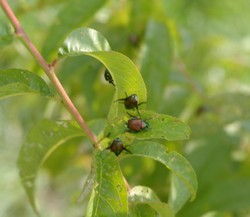

 I Loved to Read in Grade School (in the 1960s)on 09/29/2018
I Loved to Read in Grade School (in the 1960s)on 09/29/2018
 Halloween Memories from the 1960son 09/17/2018
Halloween Memories from the 1960son 09/17/2018
 What on Earth is Earthing?on 06/03/2015
What on Earth is Earthing?on 06/03/2015
 Worm Manure (Castings) Is The Best Organic Fertilizeron 05/25/2015
Worm Manure (Castings) Is The Best Organic Fertilizeron 05/25/2015

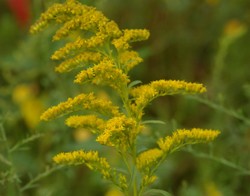
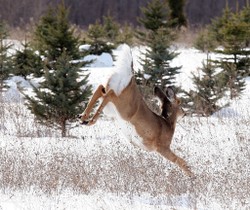
What Garden Insects Do You Have to Battle?
happynutritionist - when I visited my grandparents as a child, he had us pick off the potato bugs and stomp them. I thought it was great fun.
My parents and grandparents would put about an inch of turpentine in the bottom of about a 10 oz. jar, and would tap them from the roses into the jar with the lid. That was my job sometimes too as a child. I hope they didn't last long.
Digby_Adams - I didn't know about Japanese beetles until I visited my sister in Tennessee a few years ago and helped pick them off. But when I was a child and visited my grandparents in Illinois, I picked off the potato beetles from their garden plants and stomped on them.
My family has been growing organic raspberries for generations. The raspberry patch is always ringed by marigolds and zinnias. Since I was a child, my job has been to hunt for Japanese beetles and drown them in soapy water.